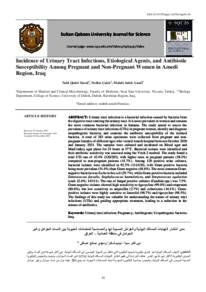Document
Incidence of urinary tract infections, etiological agents, and antibiotic susceptibility among pregnant and non-pregnant women in Amedi region, Iraq.
Identifier
DOI:10.53539/squjs.vol29iss3pp16-26
Source
Sultan Qaboos University Journal for Science, v. 29, no. 3, p. 16-26.
Contributors
Çakir, Nedim., Author
Assafi, Mahde Saleh., Author
Other titles
انتشار التهابات المسالك البولية والعوامل المسببة لها ومدى حساسية المضادات الحيوية بين النساء الحوامل وغير الحوامل في منطقة العمادية، العراق.
Country
Oman
City
Muscat
Publisher
College of Science, Sultan Qaboos University.
Gregorian
2024
Language
English
English abstract
Urinary tract infection is a bacterial infection caused by bacteria from the digestive tract entering the urinary tract. It is more prevalent in women and remains the most common bacterial infection in humans. The study aimed to assess the prevalence of urinary tract infections (UTIs) in pregnant women, identify and diagnose uropathogenic bacteria, and examine the antibiotic susceptibility of the isolated bacteria. A total of 283 urine specimens were collected from pregnant and non-pregnant females of different ages who visited Amedi hospital between October 2020 and January 2021. The samples were cultured and incubated on Blood agar and MacConkey agar plates for 24 hours at 37°C. Bacterial isolates were identified, and their antibiotic sensitivity was assessed using the Vitek-2 method. The study found a total UTI rate of 42.4% (120/283), with higher rates in pregnant patients (58.3%) compared to non-pregnant patients (41.7%). Among 120 positive urine cultures, bacterial isolates were identified in 92.5% (111/120), with Gram-positive bacteria being more prevalent (51.4%) than Gram-negative (48.6%). The most common Gram-negative bacteria was Escherichia coli (29.7%), while Gram-positive bacteria included Enterococcus faecalis, Staphylococcus haemolyticus, and Streptococcus agalactiae (each 12.6%; 14/111). The rate of fungal positive cultures (Candida spp.) was 7.5%. Gram-negative isolates showed high sensitivity to tigecycline (99.0%) and ertapenem (80.6%), but low sensitivity to ampicillin (2.7%) and cefuroxime (16.1%). Gram-positive isolates were highly sensitive to linezolid (98.7%) and tigecycline (98.5%). The findings of this study are valuable for understanding the nature of urinary tract infections (UTIs) and guiding appropriate treatment, leading to a reduction in the misuse of antibiotics.
ISSN
2075-0528
Resource URL
Arabic abstract
التهاب المسالك البولية هو عدوى بكتيرية تسببها البكتيريا التي تنتقل من الجهاز الهضمي إلى المسالك البولية. تبقى أكثر شيوعًا لدى النساء وهي العدوى البكتيرية الأكثر شيوعًا بين البشر. هدفت الدراسة إلى تقييم انتشار التهابات المسالك البولية (UTIs) بين النساء الحوامل، وتحديد وتشخيص البكتيريا الممرضة، وفحص حساسية البكتيريا المعزولة تجاه المضادات الحيوية. تم جمع 283 عينة بول من نساء حوامل وغير حوامل زرن مستشفى العمادية بين أكتوبر 2020 ويناير 2021. تم زراعة العينات على أطباق آجار الدم وآجار مككونكي لمدة 24 ساعة عند 37 درجة مئوية. تم تحديد عزلات البكتيريا وتقييم حساسيتهن للمضادات الحيوية باستخدام طريقة Vitek-2. وجدت الدراسة معدل إجمالي لالتهابات المسالك البولية بنسبة 42.4% (120/283)، مع معدلات أعلى بين المرضى الحوامل (58.3%) مقارنة بالمرضى غير الحوامل (41.7%). من بين 120 مزرعة بول إيجابية، تم تحديد عزلات بكتيرية في 92.5% (111/120)، حيث كانت البكتيريا موجبة الجرام أكثر شيوعًا (51.4%) مقارنة بالبكتيريا سالبة الجرام (48.6%). كانت الإشريكية القولونية هي الأكثر شيوعًا بين البكتيريا سالبة الجرام (29.7%)، بينما تضمنت البكتيريا موجبة الجرام المكورات المعوية البرازية، والمكورات العنقودية الدموية، والمكورات العقدية القاطعة للدرع (كل منها 12.6%؛ 14/111). كان معدل المزارع الإيجابية الفطرية (Candida spp.) هو 7.5%. أظهرت العزلات سالبة الجرام حساسية عالية تجاه تيجيسيكلين (99.0%) وإرتابينيم (80.6%)، ولكن حساسية منخفضة تجاه أمبيسيلين (2.7%) وسيفوروكسيم (16.1%). أظهرت العزلات موجبة الجرام حساسية عالية تجاه لاينزوليد (98.7%) وتيجيسيكلين (98.5%). تعتبر نتائج هذه الدراسة ذات قيمة لفهم طبيعة التهابات المسالك البولية (UTIs) وتوجيه العلاج المناسب، مما يؤدي إلى تقليل الاستخدام السيئ للمضادات الحيوية.
Category
Journal articles

